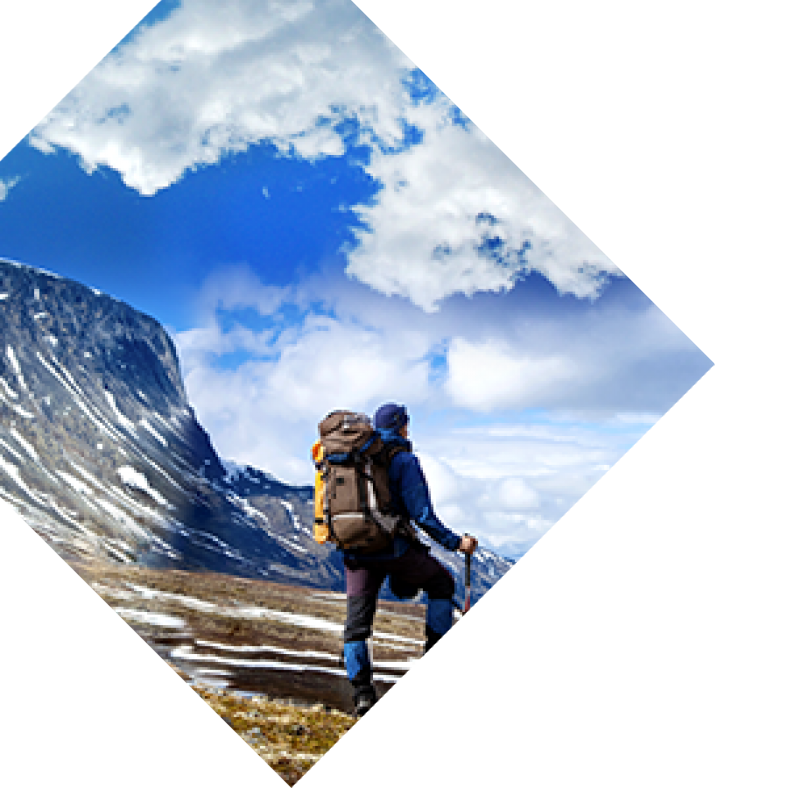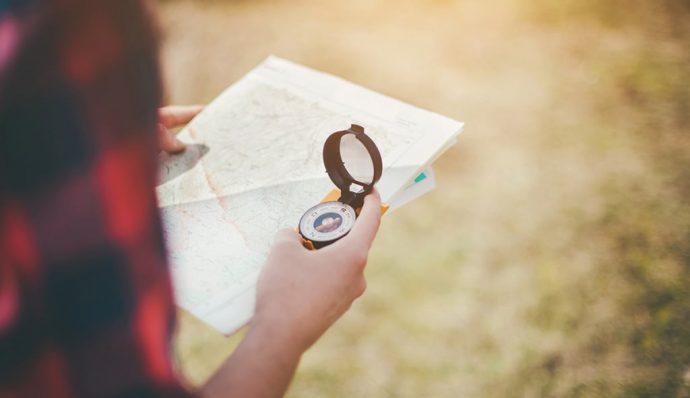 Having the right compass is crucial when you’re out in nature: on-trail or off. A GPS can be tempting; however, if the signal drops, if you drop it and it breaks, or if the batteries die, it’s useless. A compass is a much more reliable tool (and cheaper!). Compasses aren’t a one-size-fits-all purchase. You want to make sure you buy the right one for the right activity, whether that’s hiking, orienteering, or survival. We’ve figured out the features to look for in each category so you can stop researching and start exploring. So read on to learn how to choose a compass for your next adventure.
Having the right compass is crucial when you’re out in nature: on-trail or off. A GPS can be tempting; however, if the signal drops, if you drop it and it breaks, or if the batteries die, it’s useless. A compass is a much more reliable tool (and cheaper!). Compasses aren’t a one-size-fits-all purchase. You want to make sure you buy the right one for the right activity, whether that’s hiking, orienteering, or survival. We’ve figured out the features to look for in each category so you can stop researching and start exploring. So read on to learn how to choose a compass for your next adventure.
Basic/Hiking Compasses
A basic compass is often used by new hikers and mountaineers, people who want to rely on something beyond the trail, but also don’t plan on wandering far from it. Although basic compasses are inexpensive and simply designed, they come equipped with all you need for safety’s sake. 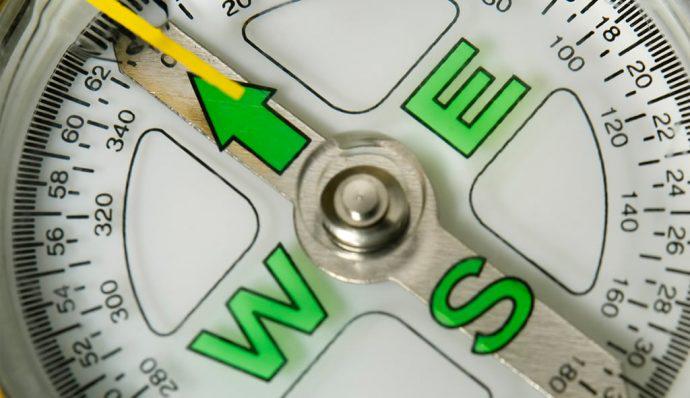
What to look for when choosing a basic compass:
- A magnetized needle that shows north quickly. Even if you’re hiking leisurely, bad weather can come on fast and you’ll want a needle that settles fast. This is called the “dampening time.” There are a couple things that help with this. The needle should be in a liquid-filled compass housing (be sure that the liquid won’t freeze!). The liquid allows to the needle to move freely and keeps it from twitching when you’re taking readings.
- A compass that’s durable. Compasses aren’t as breakable as a GPS, but that doesn’t mean they won’t bump against something in your backpack or that you won’t drop one accidentally. You want to be sure that nothing will break or shatter in that instance.
- A bezel with high resolution. The bezel is circular, moveable, and it surrounds the compass housing. There are degrees on it: 0 to 360. The best bezels are more precise — they have markings for every degree or half-degree. Pick the most precise one you can.
- A compass with a wide temperature range. If you’re hiking in low temperatures, you want to make sure your compass can keep up.
- A see-through baseplate. This will help when you’re working with maps so that you can see what’s beneath it when you’re taking a bearing.
- A baseplate with a direction-of-travel arrow, rulers on the sides, an orienting arrow, parallel median lines, and a magnifying lens to help read small symbols on your map.
- A lanyard attached to the baseplate so that you can keep your compass around your neck or tied to your belt or pack. This will keep it from getting lost.
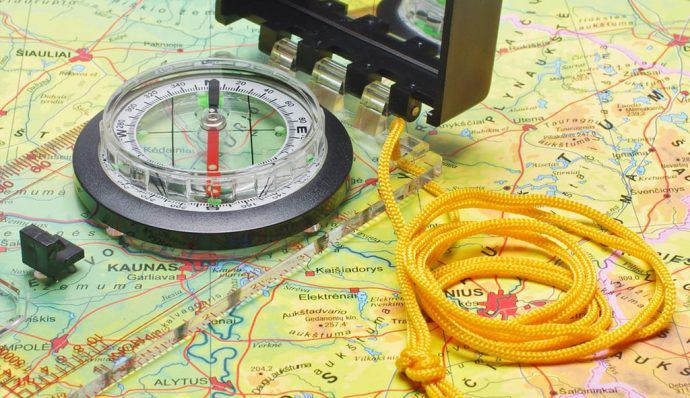
Orienteering Compasses
The next step up is an orienteering compass, made for adventurers who want to chart their own course. In this instance, you need all the features of a basic compass, but a few extras as well.
Features of an orienteering compass:
- Declination adjustment, or a small tool attached to the compass lanyard that can turn a screw on the compass housing. Turning this screw changes the direction of the orienting arrow so that it doesn’t point from true north to south, but is instead offset to account for the magnetic declination of the area you’re traveling in.
- A sighting mirror and notch. The sighting mirror often flips up like a compact and the sighting notch sits at the top. You look through the notch to target a landmark and use the mirror to see the bezel at the same time. This allows for more precise bearings. The mirror can also be used as a signaling device in times of danger.
- Luminescent indicators on the bezel so that you can take bearings in the dark or in low light.
- A clinometer, which assists you in measuring slope. This is useful when determining how steep a mountain is or how severe the risk of an avalanche may be (if you’re traveling in wintry conditions).
- A reciprocal scale, which shows the opposite direction in degrees of your direction of travel. This can come in handy when you’re trying to figure out your position on a map. For example, if you find that a bridge is at a bearing of 240 degrees and a fork in a river is at a bearing of 300 degrees, the opposite bearings would be 60 and 120 degrees, respectively. When you look at your map, you can draw a line from the bridge at the direction of 60 degrees and a line from the fork at a direction of 120 degrees. Your position is where the lines intersect.
- Silicon feet that can grip onto your map so your compass doesn’t slip as you take a reading.
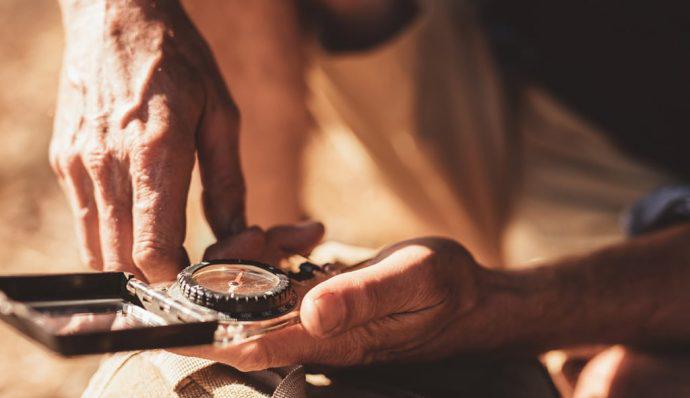 You also might want to consider using a thumb-held compass as a back-up. These were specifically designed with orienteering in mind. Although they can lack some of the features of other compasses, they stay tight on your thumb as you’re hiking and their needles are known for being quick and sensitive. Since a thumb-held compass is shaped differently and functions differently than a traditional compass, you should make sure to familiarize yourself with it before relying on it in the wild.
You also might want to consider using a thumb-held compass as a back-up. These were specifically designed with orienteering in mind. Although they can lack some of the features of other compasses, they stay tight on your thumb as you’re hiking and their needles are known for being quick and sensitive. Since a thumb-held compass is shaped differently and functions differently than a traditional compass, you should make sure to familiarize yourself with it before relying on it in the wild.
Survival Compasses
Once you’ve mastered hiking and orienteering, you might get the urge to tackle more intense hikes. In which case, you’ll need more intense tools as well. Survival compasses have all the features of basic and orienteering compasses, but also:
- A whistle to signal to hikers if you need to. It’s good to know that one sharp whistle means stop, two means “come to me”, and three means “come to me quickly”.
- A luminous bezel for night use.
- A housing made of an anodized metal. Anodization is a process by which you submerge metal into an acidic liquid and apply an electric current so as to coat the metal and prevent corrosion. This makes your compass more durable.
- A global needle. Most compasses are suited for use in either the northern or southern hemisphere, but not both. A global needle corrects for the difference. It also doesn’t have to be level to take a precise reading, as the needle handles tilts up to 20 degrees.
- Proofing for all conditions, including water, sand, and shocks.
- A jewel bearing that reduces friction for more accurate measurements.
Compasses are essential equipment for any hiker, and without knowing what you’re looking for, they can be a hard purchase to approach. Rest assured, though: No matter the intensity of your hike, whether you’re hiking on-trail or off, there is a compass made to suit your needs. With this guide in hand, you’ll be able to find the right tool for your hike. Next: Learn how to use your new compass.

